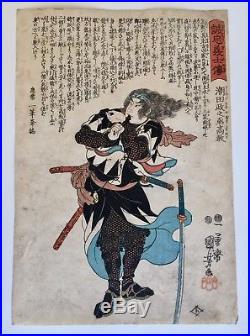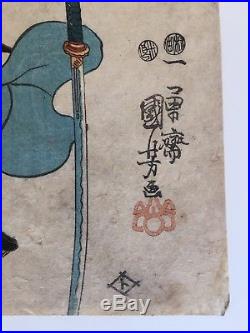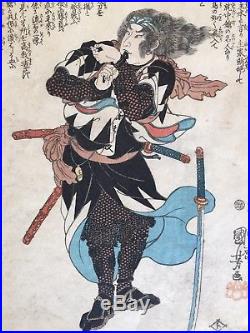TITLE: Ushioda Masanojo Takanori fastening his wrist strap. SERIES: The Faithful Samurai. MEDIUM: Authentic polychrome woodblock print; ink and color on handmade paper. 14 5/8 x 10 ¼; (37,1 cm x 26 cm). He was active in the Edo Period during the final years of the Tokugawa shogunate. His work was diverse and covered a broad range of subjects. However, he is best known for his dynamic warrior prints such as this one. Utagawa Kuniyoshis masterworks are in the collections of many of the worlds great museums. Among them are the Metropolitan Museum of Art, New York; the Museum of Fine Arts, Boston; the British Museum, London; the State Hermitage Museum, Saint Petersburg, Russia; and the Tokyo National Museum, Tokyo. CONDITION: Original Edo Period antique print. Very good condition for age. Beautiful color and wonderful detail. Some soiling, thinning, slight rubbing, small repairs. Please take a moment to examine the scans carefully. The True Story of the Faithful Samurai. During the Tokugawa era, the shogun required his daimyo (feudal lords) to visit him in Edo to take part in ceremonies and official events. In 1701 Lord Asano Takumi-no-Kami of Ako was ordered to participate in a ceremony that required frequent rehearsals and special protocol taught by Kira Kozuke-no-Suke, the shogun’s chief chamberlain. The chamberlain either insisted on bribes that were not forthcoming, or was unhappy with the small gifts presented to him, so he became increasingly insulting and humiliating towards the daimyo. Unable to take the insults any longer, Lord Asano drew his sword and struck Kira, an act of violence forbidden within palace grounds. Although the wound was not fatal, Lord Asano was arrested and forced to commit seppuku (ritual suicide). His lands were confiscated, and his retainers dispersed, becoming ronin (leaderless samurai). Oishi Kuranosuke, Lord Asano’s chief councilor, surrendered the castle and dispersed the household as ordered, but he secretly recruited a band of samurai from Ako to avenge their master’s honor. The ronin patiently waited and planned for more than a year, knowing that if their plan succeeded, they would face seppuku themselves. On a snowy night in December 1702, the band of forty-seven ronin attacked Kira’s castle and beheaded him. They took Kira’s head back to Lord Asano’s grave and awaited their arrest. In 1703 the shogun ordered all of the ronin to commit seppuku, and they were buried in Sengakuji temple next to their master, whose death they had finally avenged. The adventure of the forty-seven ronin immediately captured the imagination of the Japanese public, who revered the warriors as heroes expressing the utmost in loyalty, bravery, and sacrifice to the code of honor. Just weeks after the culmination of the event, stories and plays were already being written about the bravery and loyalty of the forty-seven ronin. The most famous account was the Kandehon Chushingura, originally written for the puppet theater in 1748 and later adapted for kabuki. To satisfy the censors, the actual names and locations were changed. The setting moved from the 18th century to the 14th, Lord Asano became Lord En’ya Hangan, and Kira became Lord Moronao. Oishi Kuranosuke, the leader of the plot, was called Oboshi Yuranosuke. Woodblock prints of the drama also became popular, depicting both individual characters and acts from the kabuki play. The incredible popularity of the play and woodblock print images continued throughout the 19th century, and still olds fascination for viewers today. The item “Original UTAGAWA KUNIYOSHI Japanese Woodblock Print” is in sale since Thursday, March 22, 2018. This item is in the category “Arte e antiquariato\Arte dal mondo\Arte orientale”. The seller is “lapovintage” and is located in Carpi, MO. This item can be shipped worldwide.




No comments